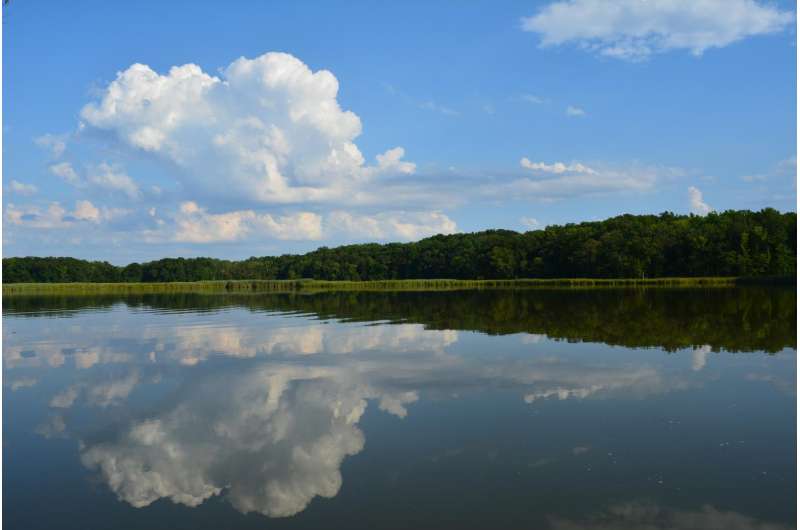This article has been reviewed according to Science X's editorial process and policies. Editors have highlighted the following attributes while ensuring the content's credibility:
fact-checked
reputable news agency
proofread
This year's Chesapeake Bay 'dead zone' was the smallest on record, going back to 1985

This summer's oxygen-poor "dead zone" in the Chesapeake Bay was the smallest since scientists started monitoring it in 1985, according to estimates by researchers in Maryland and Virginia.
The good news for the bay could reflect the lower-than-average rainfall in the bay watershed this year, experts said. Rainwater carries pollutants into the Chesapeake, inundating the estuary with nutrients such as nitrogen and phosphorous from farm fields, lawns and city streets, which trigger the growth of algae blooms that draw oxygen from the water as they decompose, creating the dead zones.
Though the dry weather this year meant many parts of Maryland experienced moderate drought conditions, it offered a welcome respite from pollution for bay wildlife, which experience stress and can perish in low oxygen conditions. But bay scientists also are hopeful that a string of smaller dead zones over the past four years indicate that strategies to reduce nutrient pollution flowing into the bay are working.
This year, the bay region experienced warmer temperatures—which tends to worsen the dead zone because hotter water holds less oxygen—but the data still showed a record low. The region also experienced average wind speeds, while breezier conditions and big storms tend to help mix oxygen into deeper waters of the bay.
"It's a testament that while you're seeing pressures through things like warmer temperatures and also population increase in the watershed, that we can still see these better-than-average results," said Mark Trice, the program chief of water quality informatics at the Maryland Department of Natural Resources, which conducts the bay survey along with Old Dominion University and the Virginia Institute of Marine Science.
The states surrounding the Chesapeake all pledged to reduce the flow of nutrient pollution into the bay by 2025, but it has become clear most states, including Maryland, will not meet their targets.
Many states found early success outfitting sewage treatment plants with updated technology to filter nutrients out of wastewater before it's dumped into waterways. But, experts said, more needs to be done to address pollution from agriculture and livestock, as well as runoff that flows into urban storm drains, abetted by concrete and asphalt surfaces that don't absorb rainwater before it reaches the bay.
Collectively, between 2009 and 2022, the bay states have met 51% of the nitrogen-reduction goal and 60% of the phosphorus-reduction goal, according to an estimate by the Chesapeake Bay Program, which oversees the bay effort.
In addition, a report released earlier this year by the Bay Program's Scientific and Technical Advisory Committee indicated that the nutrient reductions achieved thus far have led to slower improvement in the bay's dissolved oxygen levels than originally hoped. That's particularly true in the bay's deepest channel, where dissolved oxygen concentrations already are lower. The report urged the Bay Program to focus more efforts on shallower tributaries, where improving conditions for wildlife might be more attainable.
In response, Maryland Gov. Wes Moore said his administration would modify its bay cleanup strategies in accordance with the recommendations.
Even so, the past few years have been a bright spot for oxygen conditions in the bay, after heavy rainfall brought the dead zone to its highest level in decades in 2019, dealing blows to oysters, crabs and underwater grasses.
To capture the data, researchers go out on the water and collect samples twice a month from May to October, when oxygen levels are likely to be worse than other times of the year. Then, the researchers at Maryland DNR use a computer model to figure out what those samples mean for the rest of the Chesapeake.
Maryland estimated the volume of low-oxygen water was 0.52 cubic miles in the bay's main stem, while scientists in Virginia, using different methodology, came up with 0.58 cubic miles. Either way, the data point is a record, and well below the historical average of 0.97 cubic miles.
For several months this summer, the low-oxygen conditions ensnared a smaller portion of the Chesapeake than in prior years, often centralized near the Bay Bridge and the middle of the main stem, according to Maryland DNR.
"In the worst conditions, we can see it going from above the Bay Bridge all the way down past the Potomac and into certain parts of Virginia," Trice said.
From May through August, the area of hypoxic—or low-oxygen—water was below average, and in early August the samples were better than they'd ever been at that time of year. September was worse than average, but in October researchers didn't find any hypoxic conditions.
It came on the heels of a nearly snow-less winter for the Baltimore region and a fairly dry spring. At BWI Thurgood Marshall Airport, 14.33 inches of precipitation fell from January to June, compared to the historical norm of 21.21 inches, according to National Weather Service data.
That meant less fresh water flowing into the bay. From October 2022 to September 2023, 65,649 cubic feet per second of water entered the Chesapeake from rivers and streams, compared to a long-term average of 79,000 cubic feet per second.
But during the past few years, that flow—as measured by the U.S. Geological Survey—was considered normal, and the bay's dead zone still was better than the historical average.
"There's a lot of news out there—stories where you'll see something good about the bay, and then maybe something not so good," Trice said. "But I think this is really a hopeful report that people can keep in mind, that we need to continue. We've done a great job doing various management actions to restore the bay, and we just need to continue."
2023 The Baltimore Sun. Distributed by Tribune Content Agency, LLC.




















